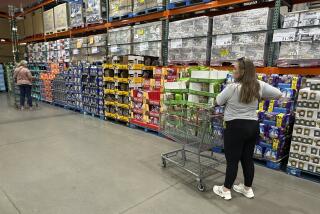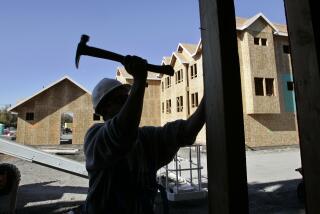Mideast Crisis Is Taking Toll on Economy
- Share via
In one of the first signs that the Persian Gulf crisis is starting to harm the economy, U.S. purchasing managers reported Tuesday that manufacturing declined in August even as inflation surged.
At the same time, the Commerce Department reported construction spending on new homes, offices and government projects rose 0.4% during July for its first gain in four months.
The National Assn. of Purchasing Management said its monthly index fell to 47% from 47.4% in July.
A reading below 50% indicates the manufacturing sector of the economy is generally declining, while one above 50% suggests it is generally expanding.
The purchasing managers’ price index soared, largely as a result of the Aug. 2 Iraqi invasion of Kuwait, to its highest level since April, 1989. The inflation index rose to 58.2% from 50.9%.
Increases in crude oil and related raw materials for industry, as well as anticipated price hikes, boosted the index. On oil markets, the price of crude oil rose more than 50% in the month.
A sharp decline in new orders in July meant lower production in August, the first decline in seven months. Overall production fell to 48.5% from 52.1% in July.
This was the lowest level since January and did not augur well for September, the report said.
In its construction spending report, the Commerce Department said spending on residential, non-residential and government buildings totaled a seasonally adjusted annual rate of $442.2 billion.
Analysts had said the weakness in the construction industry was due to consumer caution, high interest rates, tight lending requirements and, in some areas, overbuilding.
“Iraq made things worse,” said David Seiders, chief economist for the National Assn. of Home Builders.
Construction spending had not risen since a 0.4% increase in March. It fell 0.9% in both May and June and 1.9% in April.
But the latest report showed spending in May and June was even weaker than first reported. The department initially had said spending in May was down just 0.3% and in June was unchanged.
Separately, the Labor Department reported that the productivity of American workers rose a revised 1.5% in the second quarter instead of 1.6% as was previously reported.
The department, in a second look at the data, stood by the earlier report that showed there had been an increase in productivity in the three months, reversing a steady drop during the past 1 1/2 years.
In the first quarter, the department reported that productivity fell 1.9%.
More to Read
Inside the business of entertainment
The Wide Shot brings you news, analysis and insights on everything from streaming wars to production — and what it all means for the future.
You may occasionally receive promotional content from the Los Angeles Times.










